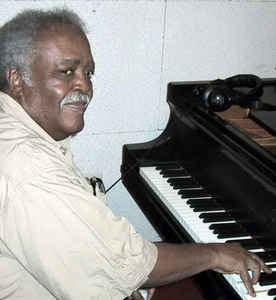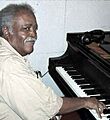Ray Bryant facts for kids
Quick facts for kids
Ray Bryant
|
|
|---|---|
 |
|
| Background information | |
| Birth name | Raphael Homer Bryant |
| Born | December 24, 1931 Philadelphia, Pennsylvania, U.S. |
| Died | June 2, 2011 (aged 79) New York City, U.S. |
| Genres | Jazz |
| Occupation(s) | Musician, composer, arranger |
| Instruments | Piano |
| Years active | 1940s–2000s |
| Labels | Columbia, Sue, Cadet, Pablo, EmArcy |
Raphael Homer "Ray" Bryant (born December 24, 1931 – died June 2, 2011) was an American jazz pianist, composer, and arranger. He was known for his unique piano style that mixed jazz with blues and gospel music. Ray Bryant played with many famous musicians and created popular songs during his long career.
Contents
Ray Bryant's Early Life and Music
Ray Bryant was born in Philadelphia, Pennsylvania, on December 24, 1931. Music was a big part of his family. His mother taught herself piano and was a minister. His father also played piano and sang. Ray had three brothers: Tommy, Len, and Lynwood.
Ray started playing the piano when he was about six or seven years old. He learned from his mother and older sister, Vera. Growing up, he played a lot of gospel music in church, which influenced his style. By his early teens, he switched from classical music to jazz. He even played the double bass in junior high school!
Ray earned his first money playing music when he was just 12. He would play for dances and sometimes even secretly in bars. He made four or five dollars a night, which was good money back then. At 14, he became a professional musician and joined a local band.
Ray Bryant's Music Career
Starting Out (1946–1958)
After playing with Mickey Collins's band for three years, Ray toured with guitarist Tiny Grimes from 1948 to 1949. He then spent a year as a solo pianist in Syracuse, New York. When he returned to Philadelphia, he played Dixieland music in a club for about two years.
Ray became more well-known in 1953 when he became the main pianist at the Blue Note club in Philadelphia. He stayed there until 1956, playing with many jazz legends like Lester Young, Charlie Parker, Miles Davis, and Sonny Stitt. Miles Davis and Sonny Rollins liked his playing so much that they recorded with him in New York in 1955.
During this time, Ray also played for singer Carmen McRae from 1956 to 1957. He was also part of trumpeter Dizzy Gillespie's bands for four months in 1957. Ray recorded several albums with drummer Art Blakey in 1957–1958. He later said these recordings helped him become a recognized musician.
Moving to New York and Hits (1959–1971)
In 1959, Ray Bryant moved to New York City. He played both traditional jazz and a newer style called hard bop. Knowing many musicians from his time in Philadelphia helped him find work quickly.
For three months in 1959, Ray was the pianist for the famous singer Ella Fitzgerald. He also recorded with other jazz artists like Hal Singer and Arnett Cobb.
For about ten years, Ray led his own trio. His brother Tommy Bryant often played bass, and drummers like Walter Perkins and Mickey Roker joined him. In 1960, he signed with Columbia Records. His first album included the hit song "Little Susie." This blues tune became very popular. Another record company quickly released their own version of Ray playing "Little Susie," which reached No. 12 on the Billboard R&B chart.
Ray also worked with singer Aretha Franklin on her 1960 album, Aretha: With The Ray Bryant Combo. He adapted one of his songs for a popular dance craze called the Madison. This new song, "Madison Time," reached No. 30 on the Billboard Hot 100 chart in 1960. Another of his singles, "Sack o' Woe," also appeared on the R&B chart in 1961.
In 1963, Ray moved to Sue Records, where he recorded four albums. Three years later, he joined Cadet Records. With Cadet, he recorded in many different styles, from small trio settings to large orchestras. He mixed jazz songs with popular pop hits of the day. Even though he never formally studied arranging, he wrote music for horns and strings on several Cadet albums.
In 1967, his cover of Bobbie Gentry's "Ode to Billie Joe" became another top 100 hit. Some jazz fans didn't like that he played pop songs, but Ray said he didn't mind. He had been playing such songs in clubs for years before they became hits.
In 1964, Ray and his brother Tommy formed a trio to play for a comedy show called Cambridge Circus in New York. The show featured famous British comedians like John Cleese and Graham Chapman.
Later Years and Performances (1972–2011)
For the rest of his career, Ray Bryant mostly performed and recorded as a solo pianist, or with a duo or trio. In 1972, he played at the Montreux Jazz Festival in Europe for the first time. He was nervous about playing for thousands of people, but it was a big success! This performance was released as the album Alone at Montreux. After this, he toured Europe often. In the 1970s, he also played electric piano.
From 1976 to 1980, Ray recorded five albums for Pablo Records. He didn't record as a leader for the next seven years, but then a Japanese producer helped him record ten more albums between 1987 and 1995. His 1989 album, All Mine and Yours, featured only his own songs and was recorded while he was touring Japan.
In the mid-1990s, he recorded with Ray Brown and Lewis Nash. He also toured the world as a solo pianist and visited Japan and Europe with a group called "100 Golden Fingers."
In the 2000s, Ray performed mostly in Europe and Japan, and he slowed down his touring schedule. Solo piano recordings from his concerts at Rutgers University in 2004 and 2008 were released on a CD called In the Back Room.
Ray Bryant passed away on June 2, 2011, in Queens, New York, at the age of 79, after a long illness.
Ray Bryant's Family
Ray Bryant was married to news broadcaster Edie Huggins from 1975 to 1982. His sister Vera's sons are also famous musicians: Kevin Eubanks, Duane Eubanks, and Robin Eubanks.
Ray Bryant's Playing Style
Ray Bryant's piano style was first influenced by pianists Art Tatum and Teddy Wilson. But soon, blues and gospel music became very strong in his playing. Ray was known for having his own easily recognizable style. He once said he liked to bring elements of the Count Basie Orchestra's sound to the piano.
Writers have described his solo piano works as being like "carefully crafted sonatas" with big changes in mood and speed. He had a strong touch on the keys and a steady sense of rhythm, especially with his left hand, which often created a solid base for his music. Even when playing fast bebop jazz, you could hear the sounds of the gospel church in his music. In his solo playing, he often played blues melodies with his right hand while his left hand played stride piano or boogie-woogie patterns.
Ray Bryant was also a composer. Some of his well-known songs include "Cubano Chant," "The Madison Time," "Monkey Business," and "Little Susie." He said that ideas for songs would just come to him while he was doing other things. If an idea stuck, he would turn it into a song. His compositions are known for their attractive melodies and rhythms, and they include different styles like Latin, blues, ballads, waltzes, and calypsos.
Ray Bryant's Albums
As a Leader
Ray Bryant released many albums where he was the main artist. Here are some of them:
- Meet Betty Carter and Ray Bryant (1955)
- Ray Bryant Trio (1956)
- Alone with the Blues (1958) – This album featured only solo piano.
- Little Susie (1959–60) – This album included his hit song "Little Susie."
- Madison Time (1960) – Featured his popular dance song.
- Hollywood Jazz Beat (1962) – With an orchestra.
- Groove House (1963)
- Live at Basin Street East (1964) – A live concert recording.
- Gotta Travel On (1966)
- The Ray Bryant Touch (1967)
- Up Above the Rock (1968)
- Alone at Montreux (1972) – A famous solo piano concert in Europe.
- Here's Ray Bryant (1976)
- Solo Flight (1976) – Another solo piano album.
- Montreux '77 (1977) – Live solo piano.
- All Mine... And Yours (1989) – This album featured only his own compositions.
- Somewhere in France (1993) – Live solo piano.
- Ray Bryant Meets Ray Brown + 1 Double RB (1994)
- In the Back Room (2004–08) – Live solo piano recordings.
As a Sideman
Ray Bryant also played piano on many albums for other famous musicians. Here are a few:
- With Miles Davis: Quintet / Sextet (1955)
- With Sonny Rollins: Work Time (1955)
- With Max Roach: Max Roach + 4 (1956)
- With Art Blakey: Drum Suite (1957)
- With Carmen McRae: After Glow (1957)
- With Dizzy Gillespie: Sonny Side Up (1957)
- With Jo Jones: Jo Jones Plus Two (1958)
- With Aretha Franklin: Aretha: With The Ray Bryant Combo (1960–61)
- With Yusef Lateef: The Gentle Giant (1971)
- With Benny Carter: Wonderland (1976)
Images for kids
See also
 In Spanish: Ray Bryant para niños
In Spanish: Ray Bryant para niños


